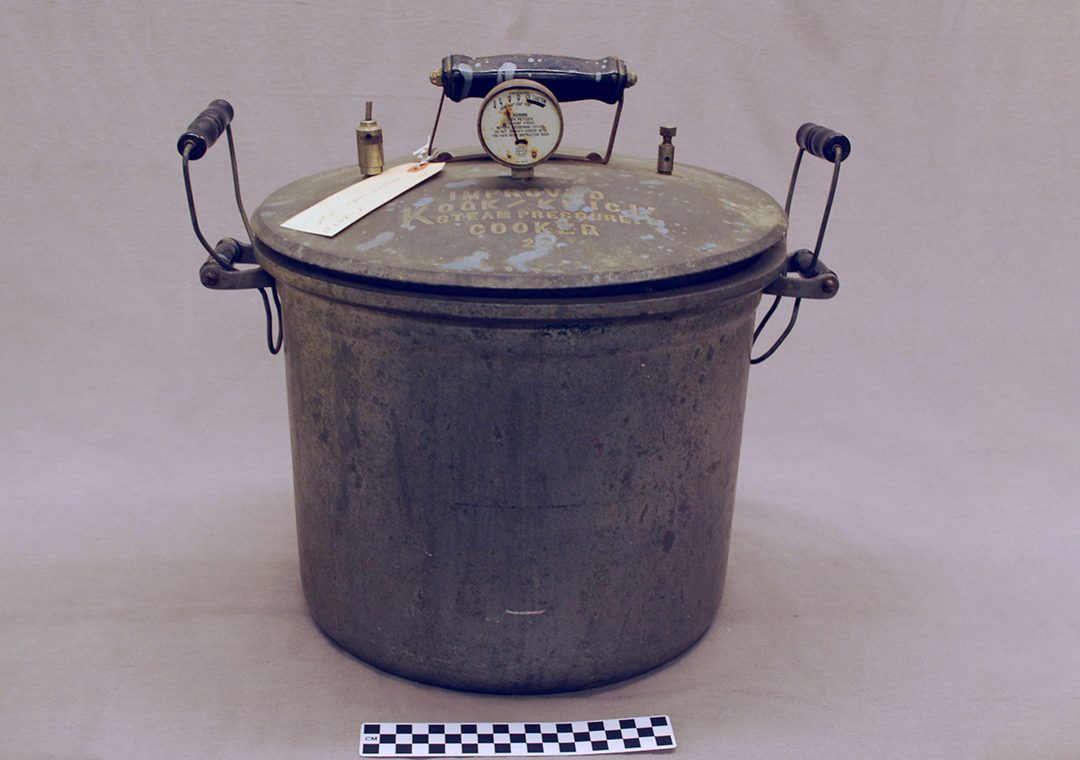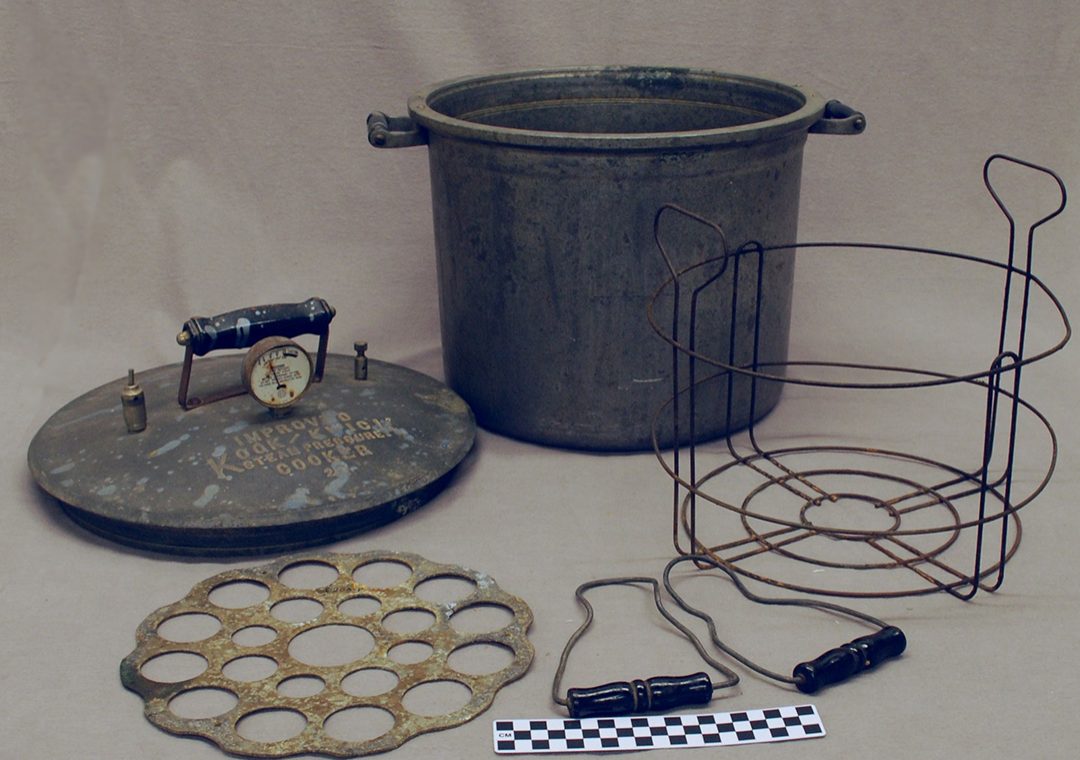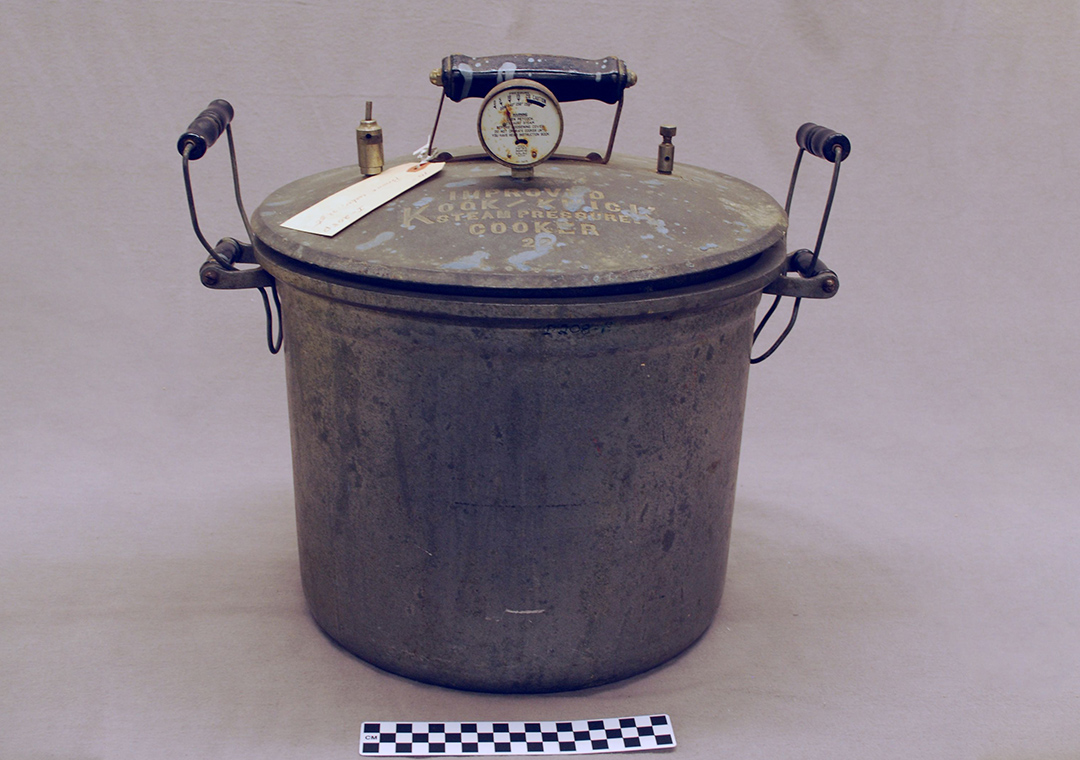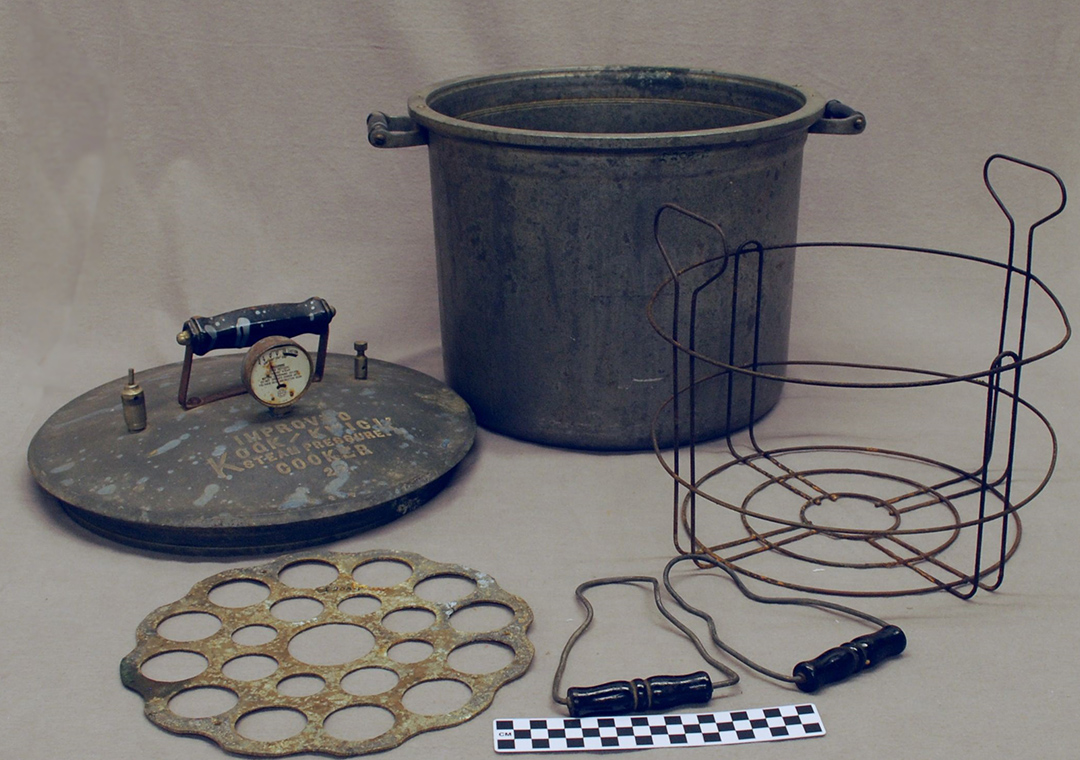This is a 22 quart “Improved Kook-Kwick Steam Pressure Cooker”. It is steel with wooden handles and has a lid with a pressure gauge. Inside is a basket to hold canning jars as well as a sheet of metal that goes in the bottom of the basket to help support the jars. The donor’s mother reportedly used this pressure cooker to can food for many years and earned the money to buy it by hiring out her ironing services to others.
Pressure cookers were a French invention. In 1679, Denis Papin developed a steam digester, sometimes called Papin’s Digester, which used steam to raise the cooking temperature as high as 266 F inside the pot. While considered an interesting study in physics, the pressure cooker did not catch on in the United States until 1939, when the first US commercial pressure cooker was unveiled at New York’s World’s Fair.
Pressure cookers create a seal through the use of a gasket. As the water heats and creates steam, it cannot easily escape. This builds up pressure within the cooker. This increased pressure allows the water to attain temperatures above the boiling point. This can both cook food more quickly, producing excellent broths and stews, and allow home cooks to easily can their own food.
Prior to modern refrigeration, preserving or “putting up” fruit and vegetables would be one of the few ways to have year-round produce that was not dried, smoked, or salted. Canning has been around since the end of the 18th Century. During the Napoleonic Wars, the French sought a way to prevent their rations from becoming spoiled. Nicolas Appert developed a way to seal food in glass containers, that preserved it longer, by keeping the container air and water-tight. This type of seal is called a hermetic seal. However, it wasn’t until Louis Pasteur wrote about the connection between microorganism growth and food spoilage that scientists began to understand why hermetic sealing. was so effective at preserving food.
In the United States, the most common form of home-canning is done in Mason Jars, a popular style of jar that has been in use since John Landis Mason patented it in 1858. The zinc metal cap and threaded neck with a separate rubber seal provided a more reliable long term storage method than previous canning methods. Two of the more common brands of canning jars available in the United States today are the Ball Mason Jar and the Kerr Mason Jar. Both types of jars are very similar in construction, with the primary difference being how the gaskets were applied to the jars. Kerr was the first to make the gasket part of the lid. Today both types of jars are made by the same parent company, though they are still manufactured under their original names.
Canning reached its height of popularity during the period from the late 19th century through the end of World War II. During the Great Depression and WWII, it was a vital way for families to survive. Especially during the war, when food was rationed, home canning in glass jars saved needed metal for the war effort, while providing extra provisions beyond what was authorized by the ration books. In fact, the government encouraged women to can fruits by allowing them extra sugar rations. It was during this time that narrower lids, like the “63” lid came into use, allowing lid manufacturers to use less metal while allowing consumers to reuse a wider variety of glass jars.
Home canning declined after the end of the War. Large corporate farms pushed out the smaller farmers, larger supermarkets created less need for home-stored produce, and better refrigeration technology made home canning less necessary. Today home canning is once again a rising trend in US culture. Some people, often referred to as “preppers,” are concerned with the potential of future emergencies or natural disasters such as storms or floods, prefer to keep a store of non-perishable food and other supplies on hand. Others, concerned with genetically modified crops, pesticides and fertilizers have begun experimenting with home gardening, and buying locally-grown organic produce for most of their fruits and vegetables. In these cases, home canning is an excellent way to ensure the quality and content of one’s food. Finally, “boutique” or small batch food production, and gourmet dining options based on local ingredients are becoming more-and-more popular, with some small businesses and restaurants capitalizing on this trend by canning their own recipes.
Since Pasteur’s discovery on the cause of food spoilage, there have been plenty of scientific research on how to prevent food from spoiling. While pressure cookers were originally designed to cook food faster, researchers have discovered that low-acid foods, such as meat, green beans, etc. need to be heated consistently at a higher temperature than can be created in a standard water bath canning method. In 1917, the US Department of Agriculture determined that pressure canning was the only safe method to can meats and other low acid content foods. Low acid foods, if not heated to 240-250 degrees, can still harbor botulism spores and cause illness. Prior to the recommendation of using a pressure cooker to can such foods, home-canned food was a common source of food poisoning.
The early pressure cookers did not have the elaborate safety features of today’s modern pressure cookers. There was a risk of explosion based on a build-up of too much pressure. Some foods could clog the steam vent and make matters worse. Even with improved safety mechanisms, it is important to follow proper safety procedures when using a pressure cooker.



